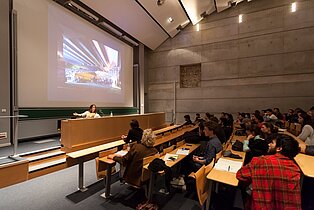Report | Amica Dall at the 2017 November Talks in Paris
The story of the London-based collective Assemble is one of resounding success. Founded by fifteen young university graduates and students in 2010, just five short years later the collective was awarded the prestigious Turner Prize for contemporary art, which has been bestowed by the Tate Gallery since 1984. This was the first time an architects' studio had won the prize. Albeit not all of the team are architects. Guest speaker Amica Dall, for example, studied literature and anthropology. Today the group has eighteen members, all dedicated to collectively working at the crossroads of architecture, art and design.
Alternative and collaborative approaches
Together with many other collectives, Assemble is part of an emerging landscape championing alternative and collaborative approaches that call into question the role of architects and fascinate students. Amica Dall had prepared a long introduction to her talk. She started with a commemoration to Lina Bo Bardi. "The artist's freedom has always been individual, but individual freedom is a myth: true freedom can only be collective."
Urban design with all its disparities
Assemble engages in urban design, with all the disparities it creates and with those that are disconnected from it. Amica Dall mentions the sociologist Robert Park. She quotes from his 1967 book On Social Control and Collective Behaviour: "The right to the city is far more than the individual liberty to access urban resources: it is a right to change ourselves by changing the city. The freedom to make and remake our cities and ourselves is, I want to argue, one of the most precious yet most neglected of our human rights." Assemble's work is based on the acknowledgement of this right. While the collective's work addresses limited physical space, it's members are called upon to work in a broader dimension: social space.
Assemble projects
Amica Dall presented two projects. The first was Granby Four Streets where, in a former working class area of Liverpool, the collective members participated in a building project initiated by the residents themselves. Offering spatial and constructional know-how, the collective supported residents in renovating their houses, which had been threatened with demolition. Particular circumstances dictated that independent implementation of the renovation project was a given. Exceptional though, was the conveyance of genuine craftsmanship know-how and the subsequent initiation of a commensurately dedicated workshop. Intervention of the architects was limited to a specific moment in the life of the project, which was nonetheless decisive for both its commencement and future.
The second project, Folly for a Flyover, was similarly important to the site in which it was brought to fruition. Assemble proposed setting up a cinema beneath a motorway flyover in London. The collective's first project was in some part a declaration based on the notion that utilisation of a site may depend on both the physical circumstances and also the way it is designed. The success of the temporary project and initiative shown by the residents later convinced the authorities to invest long-term in the design of this public space.
Assemble is a project
Assemble is not an architect studio that realises projects, it is itself a project. Assemble embodies the concept of collective, free and inclusive urban design. Assemble represents an attempt to develop an administrative structure, the objective of which is to enable the permanent entrenchment of an alternative approach. An alternative approach and some exceptional tools: artistic and architectural forms of living, collaborative work, recycling. Exceptional tools and a new organisational set-up: Assemble doesn't function like a normal architects' office. And due to the resulting success, a series of processes had to be introduced to deal with it. Similar to an architectural project, their first work mirrored formal experiments such as organisation, task allocation; participation, inclusion of residents as well as working out and funding the assignment. The quest for structures and coherence has now intensified to guarantee the stability of the group.
Lucie Jouannard
Interview with Amica Dall
The Video can be found on our YouTube-Channel.













